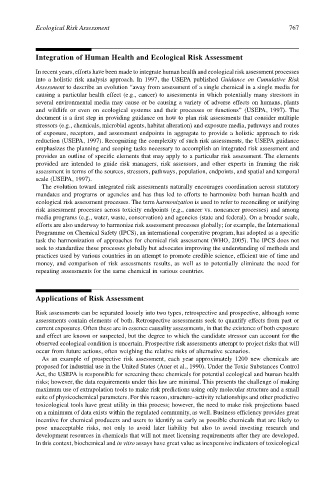Page 787 - The Toxicology of Fishes
P. 787
Ecological Risk Assessment 767
Integration of Human Health and Ecological Risk Assessment
In recent years, efforts have been made to integrate human health and ecological risk assessment processes
into a holistic risk analysis approach. In 1997, the USEPA published Guidance on Cumulative Risk
Assessment to describe an evolution “away from assessment of a single chemical in a single media for
causing a particular health effect (e.g., cancer) to assessments in which potentially many stressors in
several environmental media may cause or be causing a variety of adverse effects on humans, plants
and wildlife or even on ecological systems and their processes or functions” (USEPA, 1997). The
document is a first step in providing guidance on how to plan risk assessments that consider multiple
stressors (e.g., chemicals, microbial agents, habitat alteration) and exposure media, pathways and routes
of exposure, receptors, and assessment endpoints in aggregate to provide a holistic approach to risk
reduction (USEPA, 1997). Recognizing the complexity of such risk assessments, the USEPA guidance
emphasizes the planning and scoping tasks necessary to accomplish an integrated risk assessment and
provides an outline of specific elements that may apply to a particular risk assessment. The elements
provided are intended to guide risk managers, risk assessors, and other experts in framing the risk
assessment in terms of the sources, stressors, pathways, population, endpoints, and spatial and temporal
scale (USEPA, 1997).
The evolution toward integrated risk assessments naturally encourages coordination across statutory
mandates and programs or agencies and has thus led to efforts to harmonize both human health and
ecological risk assessment processes. The term harmonization is used to refer to reconciling or unifying
risk assessment processes across toxicity endpoints (e.g., cancer vs. noncancer processes) and among
media programs (e.g., water, waste, conservation) and agencies (state and federal). On a broader scale,
efforts are also underway to harmonize risk assessment processes globally; for example, the International
Programme on Chemical Safety (IPCS), an international cooperative program, has adopted as a specific
task the harmonization of approaches for chemical risk assessment (WHO, 2005). The IPCS does not
seek to standardize these processes globally but advocates improving the understanding of methods and
practices used by various countries in an attempt to promote credible science, efficient use of time and
money, and comparison of risk assessments results, as well as to potentially eliminate the need for
repeating assessments for the same chemical in various countries.
Applications of Risk Assessment
Risk assessments can be separated loosely into two types, retrospective and prospective, although some
assessments contain elements of both. Retrospective assessments seek to quantify effects from past or
current exposures. Often these are in essence causality assessments, in that the existence of both exposure
and effect are known or suspected, but the degree to which the candidate stressor can account for the
observed ecological condition is uncertain. Prospective risk assessments attempt to project risks that will
occur from future actions, often weighing the relative risks of alternative scenarios.
As an example of prospective risk assessment, each year approximately 1200 new chemicals are
proposed for industrial use in the United States (Auer et al., 1990). Under the Toxic Substances Control
Act, the USEPA is responsible for screening these chemicals for potential ecological and human health
risks; however, the data requirements under this law are minimal. This presents the challenge of making
maximum use of extrapolation tools to make risk predictions using only molecular structure and a small
suite of physicochemical parameters. For this reason, structure–activity relationships and other predictive
toxicological tools have great utility in this process; however, the need to make risk projections based
on a minimum of data exists within the regulated community, as well. Business efficiency provides great
incentive for chemical producers and users to identify as early as possible chemicals that are likely to
pose unacceptable risks, not only to avoid later liability but also to avoid investing research and
development resources in chemicals that will not meet licensing requirements after they are developed.
In this context, biochemical and in vitro assays have great value as inexpensive indicators of toxicological

